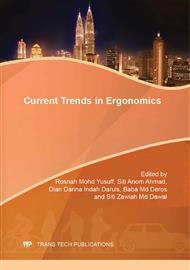[1]
C. Jensen, C. Ryholt, H. Burr, E. Villadsen, H. Christensen, Work-related psychosocial, physical and individual factors associated with musculoskeletal symptoms in computer users, Work & Stress. 16(2) (2002) 107-120.
DOI: 10.1080/02678370210140658
Google Scholar
[2]
B. Bigland-Ritchie, J. Woods, Changes in muscle contractile properties and neural control during human muscular fatigue, Muscle & Nerve. 7(9) (1984) 691-699.
DOI: 10.1002/mus.880070902
Google Scholar
[3]
U. Lundberg, M. Forsman, G. Zachau, M. Eklöf, G. Palmerud, B. Melin, et al. Effects of experimentally induced mental and physical stress on trapezius motor unit recruitment, Work & Stress. 16 (2002) 166-178.
DOI: 10.1080/02678370210136699
Google Scholar
[4]
U. Lundberg, R. Kadefors, B. Melin, G. Palmerud, P. Hassmén, M. Engström, et al. Psychophysiological stress and EMG activity of the trapezius muscle, Int J Behav Med. 1(4) (1994) 354-370.
DOI: 10.1207/s15327558ijbm0104_5
Google Scholar
[5]
H. R. Zadry, S. Z. Dawal, Z. Taha, The relation between upper limb muscle and brain activities in two precision levels of repetitive light tasks, Int J Occup Safety Ergonomics. 17(4) (2011) 373–384.
DOI: 10.1080/10803548.2011.11076901
Google Scholar
[6]
S. Mathiassen, J. Winkel, Physiological comparison of three interventions in light assembly work: reduced work pace, increased break allowance and shortened working days, Int Arch Occup Environ Health. 68(2) (1996) 94-108.
DOI: 10.1007/bf00381241
Google Scholar
[7]
MIDA, Business Opportunities in Malaysia's Electronics Industry, Malaysia, (2004).
Google Scholar
[8]
G. O. Malaysia, Eighth Malaysia Plan 2001-2005, Economic Planning Unit Malaysia, (2001).
Google Scholar
[9]
H. Chee, K. Rampal, Work-related musculoskeletal problems among women workers in the semiconductor industry in Peninsular Malaysia, Int J Occup Environ Health. 10(1) (2004) 63-71.
DOI: 10.1179/oeh.2004.10.1.63
Google Scholar
[10]
K. Voge, J. Dingwell, Relative timing of changes in muscle fatigue and movement coordination during a repetitive one-hand lifting task, Proceedings of the 25th Annual International Conference of the IEEE Engineering in Medicine and Biology Society, 17-21 Sept. 2003. 2 (2003).
DOI: 10.1109/iembs.2003.1279767
Google Scholar
[11]
I. Kuorinka, B. Jonsson, A. Kilbom, H. Vinterberg, F. Biering-Sørensen, G. Andersson, et al., Standardised Nordic questionnaires for the analysis of musculoskeletal symptoms, Appl Ergon. 18(3) (1987) 233-237.
DOI: 10.1016/0003-6870(87)90010-x
Google Scholar
[12]
K. Walker-Bone, I. Reading, D. Coggon, C. Cooper, K.T. Palmer, The anatomical pattern and determinants of pain in the neck and upperlimbs: an epidemiologic study, Pain. 109 (2004) 45–51.
DOI: 10.1016/j.pain.2004.01.008
Google Scholar
[13]
M. Ghasemkhani, E. Mahmudi, H. Jabbari, Musculoskeletal Symptoms in Workers, Int J Occup Safety Ergonomics. 14(4) (2008) 455–462.
DOI: 10.1080/10803548.2008.11076784
Google Scholar
[14]
B. Widanarko, S. Legg, M. Stevenson, M., J. Devereux, A. Eng, A. Mannetje, et al. Prevalence of musculoskeletal symptoms in relation to gender, age, and occupational/industrial group, Int J Ind Ergon. 41 (2011) 561-572.
DOI: 10.1016/j.ergon.2011.06.002
Google Scholar
[15]
H.A.H. Wijnhoven, H.C.W. De Vet, H.S.J. Picavet, Prevalence of musculoskeletal disorders is systematically higher in women than in men, Clin J Pain. 22(8) (2006) 717.
DOI: 10.1097/01.ajp.0000210912.95664.53
Google Scholar
[16]
B. Silverstein, D. Adams, Work-related musculoskeletal disorders of the neck, back, and upper extremity in Washington State, 1997-2005, Technical Report Number 40-11-2007, December 2007, SHARP Program.
Google Scholar
[17]
E. Vingård, L. Alfredsson, M. Hagberg, A. Kilbom, T. Theorell, M. Waldenström, M., et al., To What Extent Do Current and Past Physical and Psychosocial Occupational Factors Explain Care-Seeking for Low Back Pain in a Working Population?: Results from the Musculoskeletal Intervention Center-Norrtälje Study, Spine. 25(4) (2000).
DOI: 10.1097/00007632-200002150-00017
Google Scholar
[16]
M.E. Robinson, E.A. Wise, Gender bias in the observation of experimental pain, Pain. 104(1) (2003) 259-264.
DOI: 10.1016/s0304-3959(03)00014-9
Google Scholar


